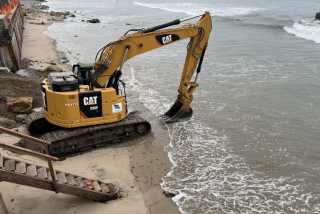Property Owners Sandbag New Jersey Beach Project
- Share via
VENTNOR, N.J. — When the deed for Lewis T. Bryant’s oceanfront property was drawn up in 1910, it included two small provisions that now have big ramifications.
One guaranteed his place by the water. The other guaranteed an ocean view.
More than 90 years later, the arcane codicils lie at the heart of a legal conundrum that is blocking a $60-million beach-replenishment project to shore up beaches in Atlantic City, Ventnor, Margate and Longport.
The restrictions didn’t exist in Bryant’s deed alone; they were included in those of several other oceanfront property owners. When those lots were divided and sold, the restrictions then attached to those properties.
About 65 property owners along the city’s 1.7-mile beach have similar covenants, giving them broad powers to protect their views and beach access.
According to the deeds:
* Those in the northern two-thirds of Ventnor--from Jackson to Richards avenues--own riparian rights to the beach itself but allow the city (through an easement) to use it for the boardwalk and recreation.
* If sand builds up the beach to a point where its high water line is more than 200 feet from the owners’ property line, the owners have the right to demand that the city move the boardwalk out toward the ocean and give the land where it had stood to the owner.
* Neither the city nor its agents may build “jetties, bulkheads, sand traps or other devices” that reach more than 2 feet above the Boardwalk’s decking.
The restrictions, which no longer appear in the actual deeds, remain in effect as part of the chains of title for the properties, according to City Solicitor John Scott Abbott.
And they have prevented the city from agreeing to participate in the U.S. Army Corps of Engineers beach-building project, which was supposed to begin last summer.
The state Department of Environmental Protection says all four communities must agree to the project or it won’t be built. To date, Atlantic City is the only one saying yes.
As designed, the project would widen 8.1 miles of beaches by up to 200 feet. But that would trigger the boardwalk-moving provision, forcing the city to spend millions of dollars.
It would also build huge sand dunes parallel to the Boardwalk on the ocean side, up to 1 foot taller than the Boardwalk decking. But the natural accretion of sand over time could build the dunes even higher, in violation of the deed restrictions.
City officials say they’re mired in a Catch-22.
If they agree to the beach replenishment, they will violate the deed restrictions and invite lawsuits from the owners, many of whom are millionaires.
If they don’t, and a coastal storm damages the boardwalk or causes serious flooding, their requests for disaster aid from the Federal Emergency Management Agency could fall on deaf ears.
The Corps has suggested using eminent domain laws to seize the sections of beach it does not own, but Mayor Timothy Kreischer said he is reluctant to do so.
For one thing, it’s bad public relations. For another, the condemnation process would end with a court setting the value of each beach parcel, which the city would have to pay to the property owners.
“If we condemn it, they’re going to take us to court, with people saying, ‘Here’s the big bad state, taking these people’s land.’ It’s like giving a blank check,” Kreischer said.
Solving the dilemma about the blocking of ocean views has been equally difficult.
The city has asked the state environmental agency for permission to “manicure” the dune tops, cutting them if they grow to more than 2 feet above the Boardwalk. The state refused.
In addition to violating the deed restrictions, the construction of view-blocking dunes could lead to property assessment challenges.
“Anybody who bought a beachfront home paid a high premium for the view,” said Marvin Levin, 74, of Elkins Park, Pa., who owns one. “If they lose the view, they will immediately seek tax relief and an assessment reduction.”
Beachfront homeowner Mel Rosenberg, 58, who is among those holding the powerful deed provisions, says they give him little comfort.
“It’s only as good as the paper it’s written on and the people who enforce it,” he said.
From his perspective, view is everything.
“I pay close to $25,000 a year in real estate taxes for the sole purpose of what they’re trying to take away from me--the view, the sound, the smell and the surf. But my view is not for sale,” he said.
Corps spokesman Rich Chlan said the agency is unaccustomed to beach towns refusing offers to replenish their eroded sand.
Because of the Corps’ all-or-nothing stance, the myriad legal issues facing Ventnor are keeping any work from being done.
“This really gets my ire up,” said Bob Levy, chief of the Atlantic City Beach Patrol. “We’ve been waiting and waiting for this thing. This process is six years long now, and we still don’t have one grain of sand that’s been moved onto any Absecon Island beaches.
“If [opponents] have their way and the Atlantic has its way,” Levy said, “people might need scuba gear to be pulling the handles on the slot machines.”
More to Read
Sign up for Essential California
The most important California stories and recommendations in your inbox every morning.
You may occasionally receive promotional content from the Los Angeles Times.










